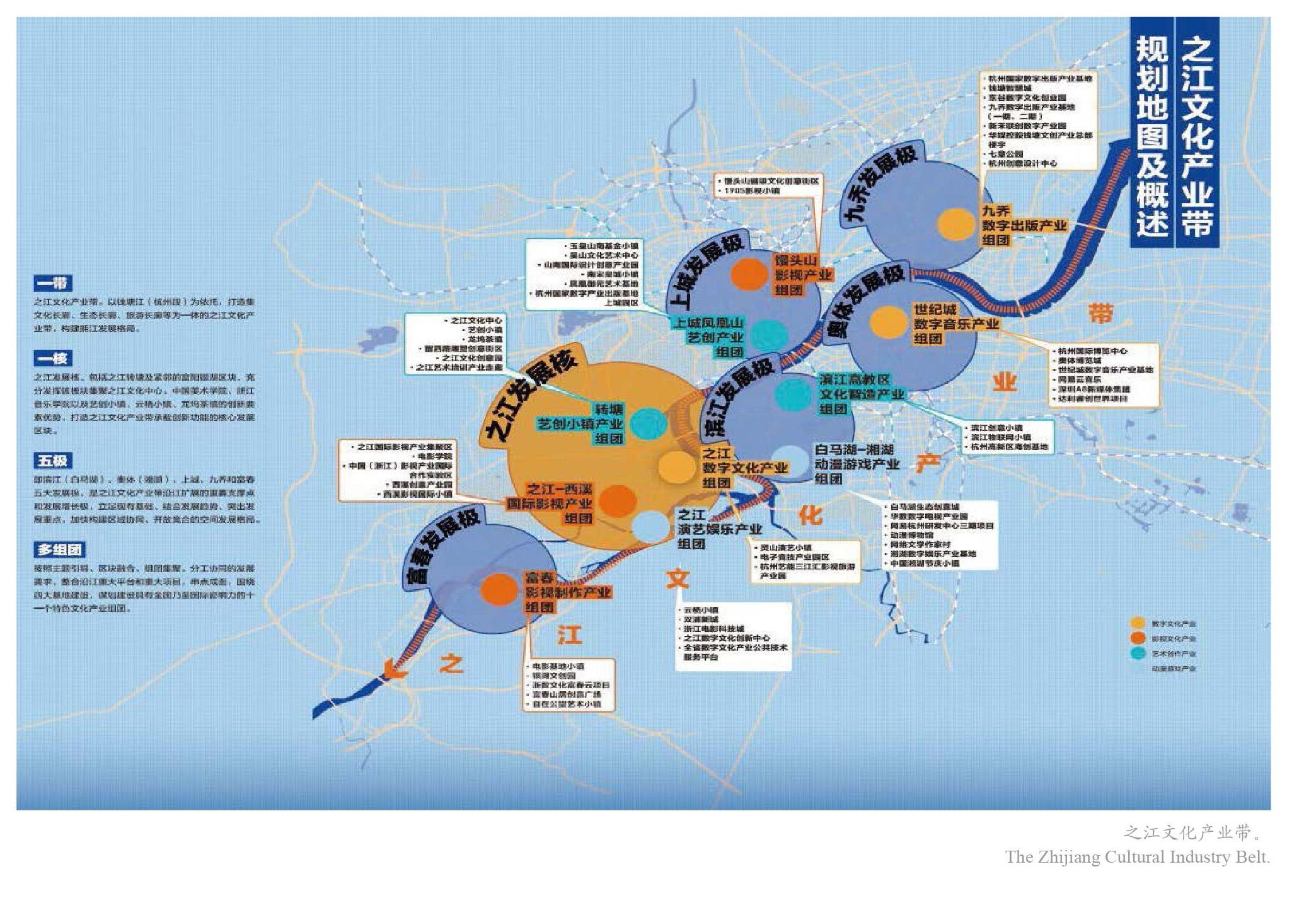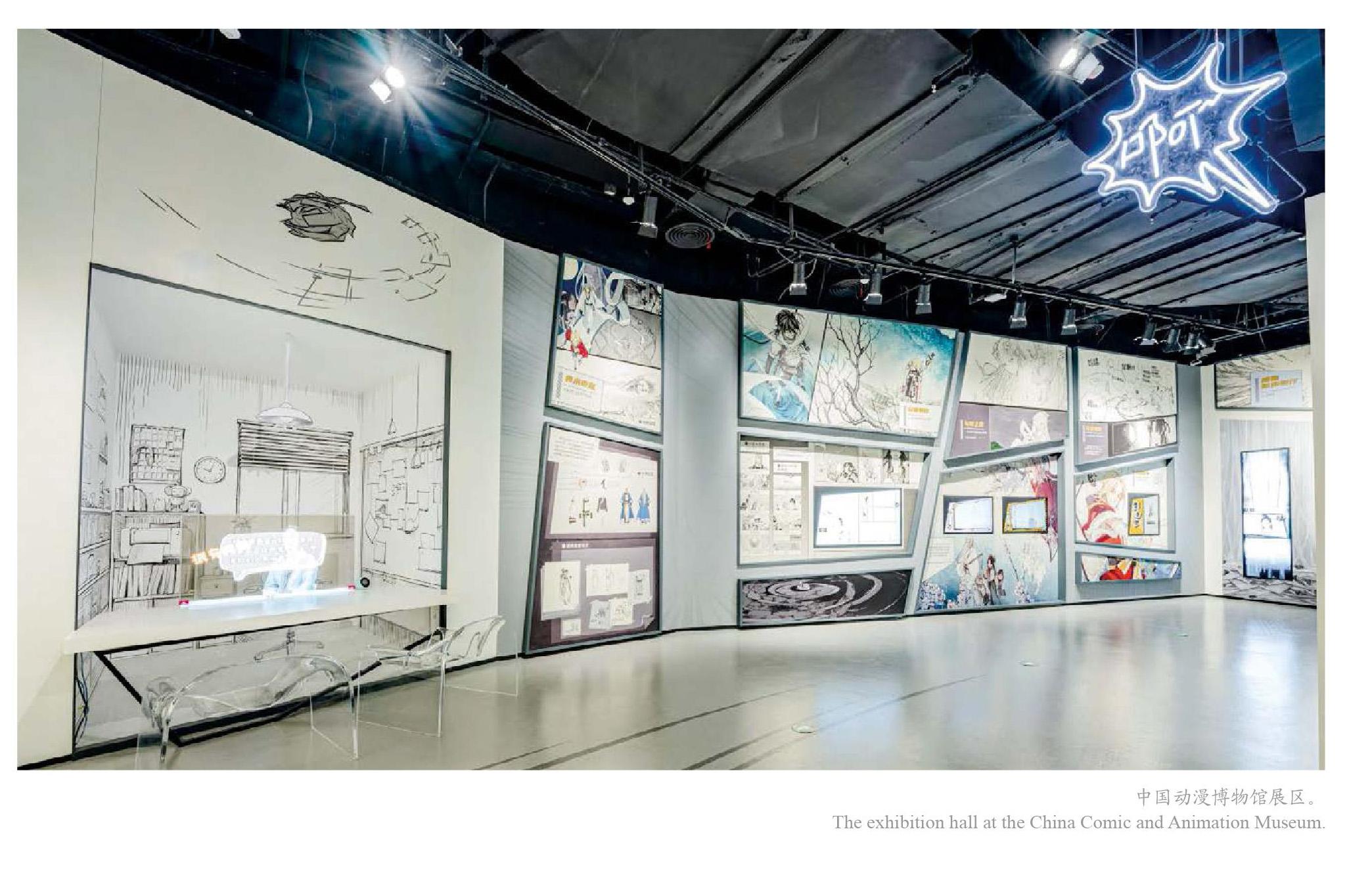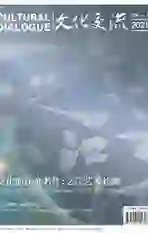之江文化产业带:融合发展示范地
2021-09-24马克强
马克强


钱塘江畔,连绵青山包围之中的“之江文化产业带”,已经成为杭州一张亮丽的金名片。
以富阳大桥到杭州经济开发区江段为轴线,向两侧延伸,范围几乎覆盖半个杭州城的之江文化产业带已基本建成。
2018年6月,之江文化产业带建设规划正式发布,提出把之江文化产业带建设成为全省文化产业发展主引擎、全国文化产业重要增长极,全力打造特色鲜明、发展领先的国际文化创意中心。
如今,之江文化产业带建设全面推进,重大产业项目纷纷落地,行业领军企业集聚,其集聚发展态势基本形成,数字文化等产业优势不断增强。
目前,之江文化产业带拥有规模以上文化企业813家,据初步测算,2019年主营业务收入超过2310亿元,区域实现增加值达700亿元以上,逐渐成为推动杭州文化产业实现新一轮快速发展的动力引擎。
“一带一核五极多组团”
按照《之江文化产业带建设规划》的空间开发格局,之江文化产业带以“一带一核五极多组团”为重点,打造6个产业能级达百亿元的文化产业集群。
具体而言,之江文化产业带将以之江新城为核心,以上城、滨江(白马湖)、奥体(湘湖)、九乔、富春作为文化产业带沿江扩展的重要支撑点和发展增长极。此外,建德、桐庐、淳安、临安、大江东产业集聚区等作为上下游延伸区,将依托各地资源禀赋,充分挖掘地方特色文化资源,因地制宜培育文化产业发展。
其中,之江文化产业带的核心——“之江发展核”,位于之江转塘及紧邻的富阳银湖区块。该核心将结合转塘双浦新城、富阳银湖区块新城建设,使之成为“之江文化产业带”的核心引擎和抢占全球数字文化产业发展制高点的重大平台。
上城发展极,以南宋皇城小镇和望江新城为核心区域,辐射上城区,以文化休闲旅游、创意设计、艺术品等行业为重点,打造兼有皇家古韵和市井风情的南宋文化体验中心和旅游国际化先行区。
滨江(白马湖)发展极,以白马湖生态创意城为核心区域,辐射滨江区,以动漫游戏、网络文学、文化会展等行业为重点,打造国内领先的文化和科技融合发展示范地。
奥体(湘湖)发展极,以钱江世纪城为核心区域,辐射萧山区,以国际化为引领,重点发展音乐产业、文化体育、文化会展等行业,打造空间集聚度高、专业特色鲜明、联动效应突出、国际风范十足的大型都市综合体。
富春发展极,以富阳辖区为核心区块,辐射富阳区,重点发展数字文化、文化休闲旅游、艺术培训等行业,打造国内知名的特色文化休闲旅游目的地和与世界名城相适应的人文发展新地标。
九乔发展极,以钱塘智慧城为核心区域,辐射江干区,联动杭州经济技术开发区,重点发展数字时尚、创意设计、互联网文化等行业,构建在全国具有广泛影响力的数字文化创意产业集群。
串起整个杭州城的之江文化产业带,将是一条集文化长廊、生态长廊、旅游长廊等为一体的产业带。
重点发展四大产业
从文化产业领域的层面来看,之江文化产业带重点聚焦4大杭州优势文化产业:数字文化产业、影视文化产业、动漫游戏产业和艺术创作设计产业。
位于西湖区沿江中间位置岸线的之江地区,在云栖小镇国际会展中心、龙坞茶镇和西湖艺创小镇等现有的文化设施建设项目的基础上,将建立象山艺术公社、之江文化中心、之江湾国际影视产业聚集区等新的重点文化产业项目,提升“之江发展核”核心的辐射力。
在“之江发展核”之外,另外数十个重大文化设施项目,分布位置规划在“五大发展极”,覆盖现有成熟完善的优质文化产业园区和基地的同时,带动新兴产业园区崛起。比如,南宋皇城小镇项目,将打造成为全国知名的体验式文化休闲旅游集聚地;中国动漫博物馆项目,是国内首家“国字号”动漫博物馆;新青年演艺产业园项目,将积极打造平台化、景区化、多功能、综合性的文化演艺产业集聚区等。
值得关注的是,数字文化产业将是规划发展的重中之重,其中西湖数字娱乐产业园作为杭州十大文化创意产业园区之一,囊括了娱乐网站、电子商务网站、VOD点播、增值服务等配套产业,产业内部和产业间已初步形成了良好的互动发展机制。
而泰豪德必易园和中国数字音乐谷两大重点项目先后开园,为之江文化产业带加快推进建设增添了新的助力。当前,在之江文化产业带动态发展的项目库中有71个项目,其中63个项目基本建设完成或开工建设,建设完成和开工率实现89%。
总体来看,之江文化产业带“一核五极多组团”的空间发展格局日渐清晰,数字文化、影视、动漫游戏、艺创设计等重点产业基础不断夯实,逐步构建起竞争有序、特色鲜明的带状文化产业发展体系。
增加值超700亿元
随著文化产业的蓬勃发展,钱塘江两岸文化要素不断被激活,集聚了越来越多的文化行业领军企业,成为浙江文化产业发展的前沿阵地。
数据显示,当前之江文化产业带拥有规上文化企业813家,文化产业已再次呈现出强大的发展韧劲和潜力,成为引领带动杭州经济社会向好发展的重要力量。
2020年10月,第十六届中国国际动漫节在杭城圆满落幕,这也是疫情以来杭州迎来的首场国字号的大型文化展会。作为之江文化产业带重点培育的会展品牌,中国国际动漫节不仅成为国内外规模最大、人气最旺、影响最广的文化专业展会,还成为疫情防控常态化背景下大型文化会展的新标杆。而每年一届的杭州文博会也将为下一步之江文化产业带建设赋予新的内涵并扩大新的影响力。
此外,针对疫情影响仍然持续的特殊情况,杭州还在全国率先以“云上办会”的形式,于2020年4月和2021年4月28日至5月5日成功举办第六届中国数字阅读大会和“云上动漫游戏产业交易会”等,为文化企业发展提供了交流推广的新渠道。
目前,在之江文化产业带区域内,除动漫节、文博会外,还培育打造了中国数字阅读大会、中国网络文学周、杭州艺术博览会、杭州国际工艺周等文化品牌活动,这一系列文化产业活动已成为杭州文化繁荣和之江文化产业带蓬勃发展的生动注脚。
Zhijiang Cultural Industry Belt: A Model to Follow
By Ma Keqiang
Culture is the soul of a global city, prosperous culture its symbol. The “Zhijiang Cultural Industry Belt”, surrounded by the West Lake, the Qiantang River and a continuous chain of green mountains, has become a shining “golden name card” for Hangzhou. Taking the area from Fuyang Bridge to Hangzhou Economic and Technological Development Zone as the axis, the belt extends to both sides and spreads over almost half of the city of Hangzhou.
When the plan to establish the Zhijiang Cultural Industry Belt was announced three years ago, it was stated that the belt would be built into the main engine of the development of the provinces cultural industry and an important growth pole of the national cultural industry, and a top international cultural and creative center would be established. Fast forward to the present, major projects have been implemented and leading enterprises of the industry have congregated in the belt, creating economies of agglomeration.
According to Zhijiang Cultural Industry Belt Development Plan, the belt centers on “one belt, one core, five poles and many clusters”, and aims to create six cultural industry clusters worth tens of billions.
Specifically, the Zhijiang Cultural Industry Belt takes Zhijiang New City as the core, with Shangcheng district, Binjiang district (White Horse Lake), Olympic Sports Center (Xianghu), Jiuqiao and Fuchun as important supporting pillars and growth poles. In addition, places including Jiande city, Tonglu county, Chunan county, Linan district, among others, will serve as the belts upstream and downstream areas, taking full advantage of their resources endowment, exploring featured local cultural resources and fostering the development of cultural industry.
The heart of the Zhijiang Cultural Industry Belt, namely the Zhijiang Development Core, overlaps with the area from Zhuantang to the adjacent Yinhe block in Fuyang county. Combined with the establishment of the Zhuantang Shuangpu New Town and the Fuyang Yinhu New Town, the core will be made into the developing engine of belt and a major platform to leverage the development of global digital cultural industry. On the basis of existing projects such as the International Exhibition Center at Yunqi Town, the Longwu Tea Town and the West Lake Artino Town, a number of key cultural projects like the Xiangshan Art Commune and the Zhijiang Cultural Center will be implemented in the belt.
In addition to the “Zhijiang Development Core”, dozens of other cultural facilities projects are planned to be built or further developed in the five growth poles, covering existing cultural industrial parks and bases, and at the same time driving the rise of emerging industrial parks. For instance, the Southern Song Dynasty Imperial Town project seeks to develop the place into a national culture and leisure tourism center; and the China Animation Museum is the first national animation museum in China.
At the industry level, the Zhijiang Cultural Industry Belt focuses on Hangzhous four “cultural industries with competitive advantages”, namely the digital cultural industry, the film and television cultural industry, the animation and games industry and the creative and design industry.
Of particular note is that the digital culture industry will be the top priority. For example, the West Lake Digital Entertainment Industrial Park, one of Hangzhous ten major cultural and creative industrial parks, covers businesses ranging from entertainment websites to e-commerce websites, from VOD (video on demand) services to value-added services, among other fields. Tellhow Dobe E-Park and China Digital Music Valley, two other key projects, have started operations, injecting new impetus to expedite the development of the Zhijiang Cultural Industry Belt.
On the whole, the spatial development pattern of “one core, five poles and many clusters” in the Zhijiang Cultural industrial belt is increasingly coming into focus. The foundation of key areas such as digital culture, film and television, animation and games, as well as artistic and creative design is constantly consolidated, and a development system with orderly competition and distinctive characteristics is gradually established.
With the vigorous development of the cultural industry, cultural elements on both sides of the Qiantang River are continuously activated, and an increasing number of leading cultural enterprises are being drawn to the Zhijiang Cultural Industry Belt, which is fast turning into the forefront of the development of cultural industry in Zhejiang province. Currently, the belt boasts a total of 813 cultural enterprises above designated size. In 2019, statistics show that its main business income exceeded 231 billion yuan, and its value-added reached more than 70 billion yuan.
A myriad of regularly organized domestic and international events have provided impetus to the development of the belt as well. The largest, the most popular and the most influential of its kind, the 16th edition of the China International Cartoon and Animation Festival was the first major international cultural festival held in Hangzhou between September and October 2020 after the COVID-19 virus struck. In the wake of the COVID-19 pandemic, Hangzhou is among the first Chinese cities to organize online conferences, expos and fairs, including the China Digital Reading Conference and Online Cartoon, Animation and Games Industrial Trade Fair, which have created new channels for the development of cultural enterprises.
At present, many more prominent events such as the annual Hangzhou Cultural and Creative Industry Expo, the China Online Literature Week, the Hangzhou Art Fair and the China Craft Week held in the Zhijiang Cultural Industry Belt have been turned into recognizable brands, testifying to Hangzhous cultural prosperity and the booming development of the belt.
